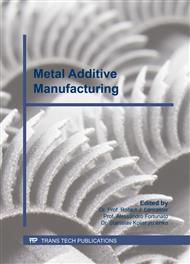[1]
Yu. G. Bobrov, V. V. Iroshnikov, Neutron activation of lithium coolant in the V-5Ti-5Cr alloy circuit, J. Nucl. Mater. s 233–237 (1996) 507–509.
DOI: 10.1016/s0022-3115(96)00055-4
Google Scholar
[2]
N. Chaia, L. Portebois, S. Mathieu, N. David, M. Vilasi, On the interdiffusion in multilayered silicide coatings for the vanadium-based alloy V-4Cr-4Ti, J. Nucl. Mater. 484 (2017) 148-156.
DOI: 10.1016/j.jnucmat.2016.11.027
Google Scholar
[3]
C. Ghosh, J. Basu, D. Ramachandran, E. Mohandas, Alloy design and microstructural evolution in V–Ti–Cr alloys, Mater. Charact. 106 (2015) 292-301.
DOI: 10.1016/j.matchar.2015.06.032
Google Scholar
[4]
K. Aoyagi, E. P Torres, T. Suda, S. Ohnuki, Effect of hydrogen accumulation on mechanical property and microstructure of V–Cr–Ti alloys, J. Nucl. Mater. s 283–287 (2000) 876-879.
DOI: 10.1016/s0022-3115(00)00140-9
Google Scholar
[5]
A. V. Fedorov, Nucleation and growth of helium-vacancy clusters in vanadium and vanadium alloys: V-5Ti, V-3Ti-1Si, V-5Ti-5Cr, J. Nucl. Mater. 233 (1996) 385-389.
DOI: 10.1016/s0022-3115(96)00032-3
Google Scholar
[6]
Y. X Gan, H. A Aglan, R. V Steward, B. A Chin, M. L Grossbeck, Microstructure–fracture toughness relationship of vanadium alloy/stainless steel brazed joints, J. Nucl. Mater. 299 (2001) 157-164.
DOI: 10.1016/s0022-3115(01)00677-8
Google Scholar
[7]
Y. Li, P. Dong, R. Li, J. Yang, J. Xie, In-situ SEM observation on the fracture of V–5Cr–5Ti alloy, J. Nucl. Mater. 421 (2012) 9-14.
DOI: 10.1016/j.jnucmat.2011.11.043
Google Scholar
[8]
K. Natesan, W. K Soppet, Effect of oxygen and oxidation on tensile properties of V-5Cr-5Ti alloy, J. Nucl. Mater. 233-237 (1996) 482-487.
DOI: 10.1016/s0022-3115(96)00235-8
Google Scholar
[9]
M. Uz, K. Natesan, V. B. Hang, Oxidation kinetics and microstructure of V-(4–5) wt% Cr-(4–5) wt% Ti alloys exposed to air at 300–650°C, J. Nucl. Mater. 245 (1997) 191-200.
DOI: 10.1016/s0022-3115(97)00008-1
Google Scholar
[10]
F. S. Qu, Z. Y. Reng, R. R. Ma, Z. H. Wang, D. M. Chen, The research on the constitutive modeling and hot working characteristics of as-cast V–5Cr–5Ti alloy during hot deformation, J. alloy. compd. 663 (2016) 552-559.
DOI: 10.1016/j.jallcom.2015.12.014
Google Scholar
[11]
L. Peng, X. Li, Z. Fan, C. Jiang, P. Zhou, X. Lai, A quasi-in-situ EBSD observation of the transformation from rolling texture to recrystallization texture in V-4Cr-4Ti alloy, Mater. Charact. 126 (2017) 35-41.
DOI: 10.1016/j.matchar.2017.01.037
Google Scholar
[12]
Z. Wang, Y. Li, Z. Wang, L. Bo, X. Zhang, L. Chao, Preparation of V-5Cr-5Ti Alloy by Vacuum Arc Remelting, Special Casting & Nonferrous Alloys. 31 (2011) 410-409.
Google Scholar
[13]
L. Cheng, Q. Li, X. F. Dong, Q. S. Li, L. X. Peng, Effect of yttrium on microstructure of V-5Cr-5Ti alloys prepared by powder metallurgy, Mater. Sci. & Eng. of Powder Metall. 20 (2015) 14-18.
Google Scholar
[14]
L. I. Yu-Fei, C. Luo, Z. Wang, D. Ren, J. Jia, Microstructure of V-4Cr-4Ti alloy fabricated by vacuum arc remelting of consumable electrode, Chin. J. Nonferrous Met. 18 (2008) 805-811.
Google Scholar
[15]
V. K. Krishnan, K. Sinnaeruvadi, Rapid Synthesis of V-4Cr-4Ti Alloy/Composite by Field Assisted Sintering Technique, Int. J. Refract. Met. H. 57 (2016) 1-11.
DOI: 10.1016/j.ijrmhm.2016.01.005
Google Scholar
[16]
E. C. Santos, M. Shiomi, K. Osakada, T. Laoui, Rapid manufacturing of metal components by laser forming, Int. J. Mach. Tool. Manu. 46 (2006) 1459–1468.
DOI: 10.1016/j.ijmachtools.2005.09.005
Google Scholar
[17]
D. H. Abbott, F. G. Arcella, Laser forming titanium components, Adv. Mater. Process. 153 (1998) 29-30.
Google Scholar
[18]
E. D. Flinn, NASA flexes its artificial muscles, Aerospace Am. 37 (1999) 22.
Google Scholar
[19]
W. Kurz, D. J. Fisher, Fundamentals of Solidification, (1998) 71-92.
Google Scholar
[20]
X. Li, A. Gagnoud, Y. Fautrelle, Z. Ren, R. Moreau, Y. Zhang, et al., Dendrite fragmentation and columnar-to-equiaxed transition during directional solidification at lower growth speed under a strong magnetic field, Acta Mater. 60 (2012).
DOI: 10.1016/j.actamat.2012.02.019
Google Scholar
[21]
M. Gäumann, S. Henry, F. Cléton, J. D Wagnière, W. Kurz, Epitaxial laser metal forming: analysis of microstructure formation, Mat. Sci. Eng. A. 271 (1999) 232-241.
DOI: 10.1016/s0921-5093(99)00202-6
Google Scholar
[22]
C. M. Liu, X. J. Tian, H. B. Tang, H. M. Wang, Microstructural characterization of laser melting deposited Ti–5Al-5Mo–5V–1Cr–1Fe near β titanium alloy, J. alloy. compd. 572 (2013) 17-24.
DOI: 10.1016/j.jallcom.2013.03.243
Google Scholar
[23]
Q. Zhang, J. Chen, X. Lin, H. Tan, W. D. Huang, Grain morphology control and texture characterization of laser solid formed Ti6Al2Sn2Zr3Mo1.5Cr2Nb titanium alloy, J mater. Process. tech. 238 (2016) 202-211.
DOI: 10.1016/j.jmatprotec.2016.07.011
Google Scholar
[24]
Q. Zhang, J. Chen, P. Guo, H. Tan, X. Lin, W. Huang, Texture and microstructure characterization in laser additive manufactured Ti–6Al–2Zr–2Sn–3Mo–1.5Cr–2Nb titanium alloy, Mater. Design 88 (2015) 550-557.
DOI: 10.1016/j.matdes.2015.09.053
Google Scholar
[25]
H. Tan. Temperature measurement and research on microstructure controlling in laser rapid forming process: Northwestern Polytechnical University; (2005).
Google Scholar
[26]
G. M. Le, A. Godfrey, N. Hansen, Structure and strength of aluminum with sub-micrometer/micrometer grain size prepared by spark plasma sintering, Mater. Design 49 (2013) 360-367.
DOI: 10.1016/j.matdes.2013.01.018
Google Scholar
[27]
G. M. Le, A. Godfrey, N. Hansen, W. Liu, G. Winther, X. Huang, Influence of grain size in the near-micrometre regime on the deformation microstructure in aluminium, Acta Mater. 61 (2013) 7072-7086.
DOI: 10.1016/j.actamat.2013.07.046
Google Scholar
[28]
N. Kamikawa, N. Tsuji, X. Huang, N. Hansen, Quantification of annealed microstructures in ARB processed aluminum, Acta Mater. 54 (2006) 3055-3066.
DOI: 10.1016/j.actamat.2006.02.046
Google Scholar
[29]
H. A. Aglan, Processing orientation - Fracture resistance relationships of V–5Cr–5Ti alloy, Mater. Lett. 62 (2008) 865-869.
DOI: 10.1016/j.matlet.2007.04.119
Google Scholar



